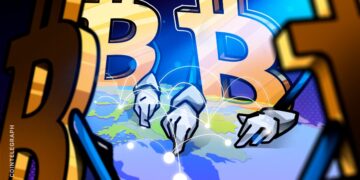Appointed head of the Federal Reserve in 2018 by Donald Trump, Jerome Powell is now the target of repeated attacks from the presidential camp. The Fed chairman is stalling, as tariffs could bring both more inflation and less growth. Meanwhile, the American president wants lower interest rates in order to obtain more favorable financing conditions. Indeed, 9 trillion dollars of US debt matures in 2025.
As US financial markets reel under the weight of new trade tensions, the confrontation between President Donald Trump and the head of the Federal Reserve, threatens to turn into a protracted tug-of-war.
On Friday, just hours before Powell was due to speak, Trump struck hard on his social platform: “REDUCE INTEREST RATES, JÉRÔME, AND STOP MAKING POLITICS!” The tug-of-war recalls the tensions of Trump’s first term, when he referred to Powell as “Clueless Jay Powell”. There is nothing to suggest that this opposition will subside.
The President can rely on several indicators. Oil prices are down, bond yields are down and food prices are down. In his view, the conditions are ripe to give global demand room to maneuver and thus enable a rate cut.
Meanwhile, Jerome Powell remains measured. He stressed the complexity of the situation and said that the Fed preferred to wait for clearer signals before acting. This cautious stance has not gone down well with some investors, who are hoping for a rapid reaction to avoid an economic shock.
Artificial intelligence models described Powell’s speech on Friday as more hawkish than any since 2022, particularly when he said, “It’s too early to say what the appropriate path for monetary policy will be.” In other words, the priority remains the fight against inflation.
The dilemma is real: if tariffs cause prices to rise, lowering rates could worsen inflation without reviving demand hampered by uncertainty.
9000 billion dollars refinancing
The pressure exerted by Donald Trump can also be explained by budgetary considerations. Most of the debt to be refinanced had been issued at rates close to 0%. Today, 10-year rates exceed 4%, representing a considerable increase in the interest burden. Lower rates would save the US Treasury billions of dollars each year. With a total public debt of $34 trillion, this would mean refinancing just over a quarter of the total debt this year.
Some analysts believe that the tariff measures are precisely designed to contain growth expectations, to enable the State to borrow at lower cost. Others consider this strategy too risky, given the impact of Donald Trump’s measures.
An economic slowdown triggered by the tariffs could thus force the Fed to ease monetary policy, although the President could well receive the downside of an inflationary surge. The Fed would then have no choice but to keep rates high to avoid a spiral of rising prices.
Is the Fed still independent?
Theoretically independent, the Fed sets monetary policy without political interference. But Donald Trump makes no secret of his skepticism. During his campaign, he declared: “The president should at least have a say.”
For Tim Duy, of SGH Macro Advisors, the red line is clear: “If Powell gives in too quickly, central bank independence is dead. Trump would then have set a precedent: use market chaos to coerce the Fed.”
Some even fear a scenario where the White House would seek to directly influence the Fed board, weakening one of the key institutions of the US economy. This prospect is of particular concern to foreign investors, already shaken by the perceived decline in institutional rigor in the United States. For the time being, this drift remains hypothetical. However, it could materialize with Donald Trump’s appointment of Jerome Powell’s successor, whose term expires in 2026.
In 2024, public debt and the budget deficit reached record levels. Against this tense backdrop, Donald Trump is further complicating matters by heightening economic uncertainty. Washington will have to juggle fiscal, monetary and trade policy, while trying to prevent a financial crisis. More than ever, the President needs the Fed’s support. Welcome to a world where even recession becomes a political tool!


















